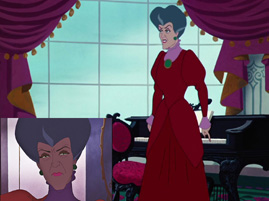 |
[Unfortunately, we could not find a picture of the prolapse of Lady Tremine's sphincter.]
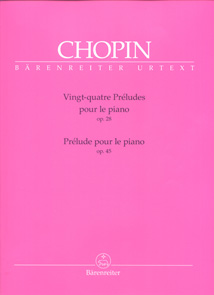 CHOPIN BÃRENREITER URTEXT
CHOPIN BÃRENREITER URTEXT
Vingt-quatre Préludes / pour le piano / op. 28
Prélude pour le piano / op. 45
Urtext Herausgegeben / Edited by von Christoph Flamm
Fingersatz und Hinweise zur Aufführungspraxis von / Fingering and Notes on Performance Practice by Hardy Rittner
Bärenreiter Kassel - Basel - London - New York - Praha / BA 9610 / © (August) 2016
We would have happily done without writing this draft of review, because this new edition of the Preludes by Chopin does not deserve our attention. But in the page concerning the best Chopin's editions we promised our readers to keep them updated. So, even though reluctantly, we take upon ourselves this thankless task. In any case we will try to be as concise as possible. It will seem to the Reader that the responsibility for this edition is to be charged to both the scholars who are the editors, but the real responsibility falls solely and exclusively on the managers of the publishing house who called them to such an unequal enterprise.
The issue, like all the other well-known ones, is defined as "Urtext", but it is not. Who wants to know what is an "Urtext" edition, should read the Allgemeiner Vorbericht to the first "Urtext" edition of the Chopin's Etudes, published in 1899 by Breitkopf & Härtel. Since the market, i.e. the potential buyers, mainly thanks to Henle editions, have been treacherously led to believe that the word "Urtext" has the magical power to transform an edition into the best one available—like the words pronounced by the priest for transubstantiating bread and wine into flesh and blood—, it is necessary to persevere in error, in order to ensure sales. When culture gives way to the market, it is no longer culture, but rather the Lady Tremaine soul's materialization.
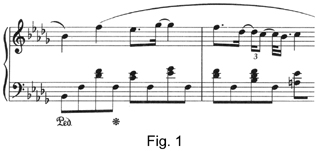 Hardy Rittner, author of the 'Notes on performance practice', recorded the complete series of the Etudes (Musikproduktion Dabringhaus und Grimm MDG 904 1747-6, Detmold 2012), thanks to which he, in the eyes of Bärenreiter's management, has gained credit as a connoisseur of the new piano school of Chopin. Nevertheless, this recording—beginning from the choice of the instrument (a Graf of 1835, subjected to a conservative restoration: a dud)—shows, on one hand, that Rittner has an excellent technical equipment, which, however, on the other, is abundantly exceeded by a complete ignorance of the Chopin's piano idea. In the short chapter about the 'Rubato' (p. XXVIIf., right col.) he writes: "Such a relational action (between the hands) (Umsetzung)[3b] ... must always proceed on the basis of musical logic, which in Prélude No. 15, bars 16f. could produce the following result: [see Fig. 1]”. An absurdity that matches with his rendition of the Etudes. It is evident that Rittner, like the most of the pianists who play Chopin, has not understood what 'rubato' really is.
Hardy Rittner, author of the 'Notes on performance practice', recorded the complete series of the Etudes (Musikproduktion Dabringhaus und Grimm MDG 904 1747-6, Detmold 2012), thanks to which he, in the eyes of Bärenreiter's management, has gained credit as a connoisseur of the new piano school of Chopin. Nevertheless, this recording—beginning from the choice of the instrument (a Graf of 1835, subjected to a conservative restoration: a dud)—shows, on one hand, that Rittner has an excellent technical equipment, which, however, on the other, is abundantly exceeded by a complete ignorance of the Chopin's piano idea. In the short chapter about the 'Rubato' (p. XXVIIf., right col.) he writes: "Such a relational action (between the hands) (Umsetzung)[3b] ... must always proceed on the basis of musical logic, which in Prélude No. 15, bars 16f. could produce the following result: [see Fig. 1]”. An absurdity that matches with his rendition of the Etudes. It is evident that Rittner, like the most of the pianists who play Chopin, has not understood what 'rubato' really is.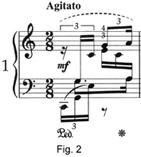
– In the first measure (Fig. 2) the first triplet (r.h.) is marekd by a bracket that Chopin never used. Why?
– The whole measure (r.h.) has a dotted slur (!?). Why?
– In the 'Critical commentary' we read: "A, CJF have instead of one continuous phrasing slur two slurs assigned to the triplets; [...] We standardise everywhere whole-bar slurring.” Why?
– Both in A and all sources the eighth rest (l.h.) is put inside the stave. Here it is outside. Why?
– The number 5 marking the quintuplets (mm. 18f.) is in all sources under the slur. Here it is over the slur. Why?
– When a measure in the upper stave has a quintuplet, in lower one Chopin marks the triplets with the number 3, absent elsewhere, to stress the different execution. The fact that the number 3 was added in mm. 24 and 27 is due to an oversight: in fact, when Chopin realized such a careless addition in m. 22, deleted the number 3.
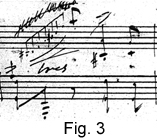 We in general have discussed the question of the importance of the graphic appearance in our edition of the Polonaises. The peculiar use, e.g., of the slurs is still ignored. As to their position, we take a random example (Fig. 3, Polonaise Op. 26 No. 1, m. 16): the slur placed over the arpeggio in small notes is erased and rewritten under it! You can find another example in the Prelude No. 2, mm. 10÷1: in A Chopin strikes off the hairpin between the staves and rewrites it over the slur in the upper staff; nonetheless, Flamm does not care and in his edition the hairpin remains placed between the staves! In Chopin each graphic sign has an exegetical and expressive function—those who ignore that, declare themselves incompetent.
We in general have discussed the question of the importance of the graphic appearance in our edition of the Polonaises. The peculiar use, e.g., of the slurs is still ignored. As to their position, we take a random example (Fig. 3, Polonaise Op. 26 No. 1, m. 16): the slur placed over the arpeggio in small notes is erased and rewritten under it! You can find another example in the Prelude No. 2, mm. 10÷1: in A Chopin strikes off the hairpin between the staves and rewrites it over the slur in the upper staff; nonetheless, Flamm does not care and in his edition the hairpin remains placed between the staves! In Chopin each graphic sign has an exegetical and expressive function—those who ignore that, declare themselves incompetent.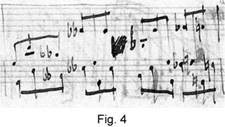 In the commentary to the m. 14 of the Prelude No. 14 we read: "A, F1, F2 without ♭ before 7th 8th note (l.p.)." Now, looking at the autograph (A, Fig. 4), such an observation looks like nothing but cumbersome ballast.
In the commentary to the m. 14 of the Prelude No. 14 we read: "A, F1, F2 without ♭ before 7th 8th note (l.p.)." Now, looking at the autograph (A, Fig. 4), such an observation looks like nothing but cumbersome ballast. 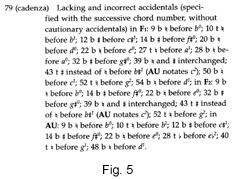 in his 'Critical commentary' Flamm is forced to lie, that is to cheat the buyers of his edition. In fact in the commentary to m. 25b writes: «F ♮ before 3rd note indistinct or lacking." False! Because in F1G, as we have shown in our edition, the ♮ is very clear. Again, in the commentary to m. 87t he writes: «In F1, F2 8th note b♯1 not dotted.! False! Because in the F1G the dot is very clear. Moreover, in our edition we have shown that the use of small notes in the so-called Cadenza is an arbitrary choice of the publisher and we also observed that the expression 'a piacere' couldn't be ascribed to Chopin. No word about that, of course. Perhaps Flamm did not want to mention our edition. In any case, his behaviour, which has nothing to do with philology, is a piece of evidence of how the soul of modern culture, embodied above by Lady Tremaine, likes to show.
in his 'Critical commentary' Flamm is forced to lie, that is to cheat the buyers of his edition. In fact in the commentary to m. 25b writes: «F ♮ before 3rd note indistinct or lacking." False! Because in F1G, as we have shown in our edition, the ♮ is very clear. Again, in the commentary to m. 87t he writes: «In F1, F2 8th note b♯1 not dotted.! False! Because in the F1G the dot is very clear. Moreover, in our edition we have shown that the use of small notes in the so-called Cadenza is an arbitrary choice of the publisher and we also observed that the expression 'a piacere' couldn't be ascribed to Chopin. No word about that, of course. Perhaps Flamm did not want to mention our edition. In any case, his behaviour, which has nothing to do with philology, is a piece of evidence of how the soul of modern culture, embodied above by Lady Tremaine, likes to show.NOTE.
[1]
We guess the meaning of Fingerpedal translated by 'finger pedaling' is close to what Gieseking meant for 'polyphonic touch'.
[2]
There is also a note written by Chopin to Pleyel and dated Saturday, August 18, 1839 (cf. J.-J. Eigeldinger, Chopin et Pleyel, Paris [2010] p. 80 e 125), but the 18th August 1839 was not Saturday!
[3]
Cf. H. Lenneberg, Breitkopf und Härtel in Paris, Stuyvesant NY [1990] p. 110: the English translation (p. 68f.) stops a little after the half!
[3b]
The English translation (“the execution of the rubato”) simplifies the German text.
[4]
There is no 'dotted rhythm', because the rhythm cannot be written: actually—as we have already emphasized elsewhere—you can write the only time division.
[4b]
Not 'to tie', as the English translator writes: either he is not a musician or does not know the quoted waltz.
[5]
Wilhelm von Lenz, Les grands virtuoses du piano, traduit et présenté par J.-J. Eigeldinger, Paris (1995) p. 174.
[All rights reserved © Franco Luigi Viero]
